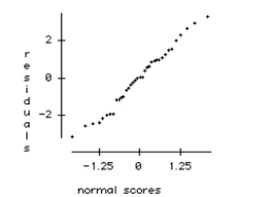For a class project, students tested four different brands of laundry detergent (1, 2, 3, 4) in
three different water temperatures (hot, warm, cold) to see whether their were any
differences in how well the detergents could clean clothes. The students took 36 identical
pieces of cloth and made them dirty by staining them with coffee, dirt, and grass. The 36
pieces were randomly assigned to the 12 combinations of detergent and temperature so
that each combination had 3 replicates. After washing, the students rated how clean the
clothes were from 0 (no change) to 20 (completely spotless). The two factor ANOVA table
is shown below along with an interaction plot and residual plots. 

a. Write the hypotheses tested by the Detergent F-ratio. Test the hypotheses and explain
your conclusion in the context of the problem.
b. Write the hypotheses tested by the Temp F-ratio. Test the hypotheses and explain your
conclusion in the context of the problem.
c. Check the conditions required for the ANOVA analysis.
Definitions:
Nominal Wage
The amount of money received by a worker per unit of time (hour, day, etc.); money wage.
Real Wage
The amount of goods and services a worker can purchase with his or her nominal wage; the purchasing power of the nominal wage.
Agency Shops
A workplace agreement where employees, whether or not they are union members, must pay union fees for the bargaining services the union provides.
Open Shops
Workplaces where union membership is not required as a condition of employment.
Q4: Draw an example of an F distribution
Q16: You roll a die 48 times
Q17: If the restaurant is open for 8
Q38: Does donating blood lower cholesterol levels? 50
Q49: Graduation tests Many states mandate tests that
Q58: Suppose the company collects 10 warranty plans
Q87: Based on data that were collected during
Q122: The speeds (in mi/h) of the
Q124: Was your test one-tail upper tail, lower
Q132: Which two events are most likely to